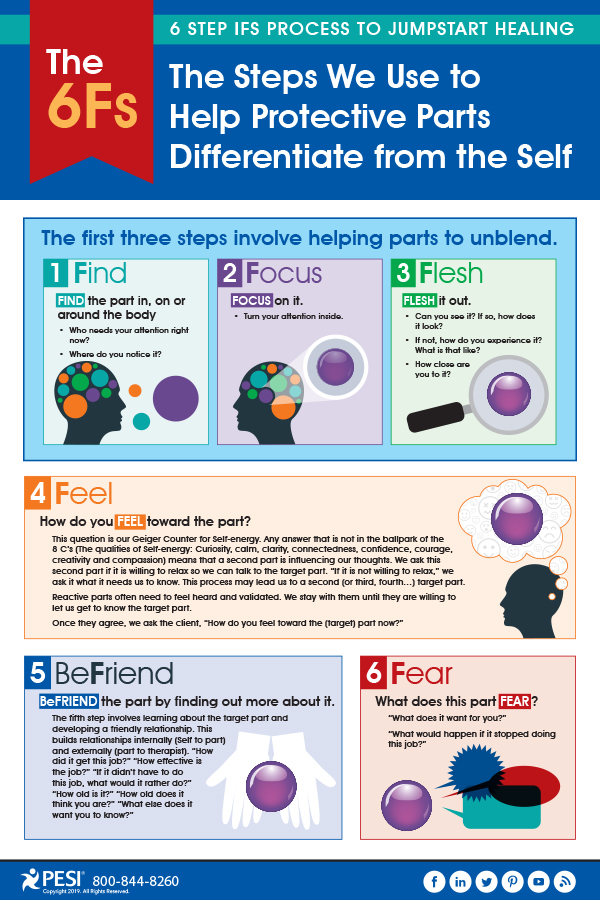6 Step IFS Process to Jumpstart Healing
Plus a FREE IFS worksheet!

You've likely heard your clients explain their feelings of conflicting emotions — "a part of me wants to…and then there’s a part of me that doesn’t…” as they grapple with their internal "Self," desires, and behaviors. In Internal Family Systems (IFS), the idea of multiplicity of the mind is normal. Every part has a good intention, and every part has value. Even for trauma survivors.
In the treatment of trauma, IFS is different from traditional phase-oriented treatments. Instead of starting with building resources in clients before processing traumatic memories, it welcomes extreme symptoms from the onset, learns about their positive protective intentions and gets their permission to access the traumatic wounds.
But before we can begin the work of healing trauma with IFS, we have to first begin by unblending our client’s various parts. We do this by walking our client’s through the 6Fs: Find, Focus, Flesh it out, Feel, beFriend and Fear.
The process is simple, and you can use the following steps as a guide to help you unblend parts with your clients...
The first three steps (find, focus, flesh out) involve helping parts to unblend.
This key question will reveal any lurking polarization.
“If I stop feeling anxious, I’m afraid the suicidal part will take over.” Or it will reveal the exile it protects.
“If I stop feeling anxious I’m afraid Jane will feel all alone and worthless.”
Use this simple exercise to help your clients understand and work with their internal parts to begin the deep healing process that trauma requires.
In the treatment of trauma, IFS is different from traditional phase-oriented treatments. Instead of starting with building resources in clients before processing traumatic memories, it welcomes extreme symptoms from the onset, learns about their positive protective intentions and gets their permission to access the traumatic wounds.
But before we can begin the work of healing trauma with IFS, we have to first begin by unblending our client’s various parts. We do this by walking our client’s through the 6Fs: Find, Focus, Flesh it out, Feel, beFriend and Fear.
The process is simple, and you can use the following steps as a guide to help you unblend parts with your clients...
The 6Fs: The Steps We Use to Help Protective Parts Differentiate from the Self
The first three steps (find, focus, flesh out) involve helping parts to unblend.
- FIND the part in, on or around the body.
- Who needs your attention right now?
- Where do you notice it?
- FOCUS on it.
- Turn your attention inside.
- FLESH it out.
- Can you see it? If so, how does it look?
- If not, how do you experience it? What is that like?
- How close are you to it?
- How do you FEEL toward the part?
- This question is our Geiger Counter for Self-energy. Any answer that is not in the ballpark of the 8 C’s (The qualities of Self-energy: Curiosity, calm, clarity, connectedness, confidence, courage, creativity and compassion) means that a second part is influencing our thoughts. We ask this second part if it is willing to relax so we can talk to the target part. “If it is not willing to relax,” we ask it what it needs us to know. This process may lead us to a second (or third, fourth…) target part.
- Reactive parts often need to feel heard and validated. We stay with them until they are willing to let us get to know the target part.
- Once they agree, we ask the client, “How do you feel toward the (target) part now?”
- BeFRIEND the part by finding out more about it.
- The fifth step involves learning about the target part and developing a friendly relationship. This builds relationships internally (Self to part) and externally (part to therapist). “How did it get this job?” “How effective is the job?” “If it didn’t have to do this job, what would it rather do?” “How old is it?” “How old does it think you are?” “What else does it want you to know?”
- What does this part FEAR?
- “What does it want for you?”
- “What would happen if it stopped doing this job?”
This key question will reveal any lurking polarization.
“If I stop feeling anxious, I’m afraid the suicidal part will take over.” Or it will reveal the exile it protects.
“If I stop feeling anxious I’m afraid Jane will feel all alone and worthless.”
Use this simple exercise to help your clients understand and work with their internal parts to begin the deep healing process that trauma requires.
Want More? Check out this FREE IFS Worksheet...

Clients with complex trauma often develop extreme protective responses in an attempt to keep the emotional pain away. When encountering these extreme reactions, it’s common for you to feel frustrated, overwhelmed, bored and at times reactive yourself. As a result, therapy can get stuck and clients can begin to feel unsafe and re-experience the helplessness they felt in their original trauma.
But there's an easy way to get therapy back on track...
Use this to help you identify the roots of your client's extreme response and determine what neuroscience-informed interventions are best for helping your clients get beyond their extreme trauma reactions — so you can help them find relief faster.
But there's an easy way to get therapy back on track...
Use this to help you identify the roots of your client's extreme response and determine what neuroscience-informed interventions are best for helping your clients get beyond their extreme trauma reactions — so you can help them find relief faster.
Want more resources for working with complex trauma?

Don't miss our new online certificate course in
Hailed by Dr. Bessel van der Kolk, the world’s leading expert in trauma, as the “treatment method all clinicians should know,” the powerful IFS approach can accelerate the healing of complex trauma — providing lasting relief for your clients sooner.
Now you can join Dr. Frank Anderson, psychiatrist, psychotherapist, author, and vice chair/director of the Foundation for Self Leadership — the leading organization dedicated to advancing the IFS model through research and training — for an intensive online course where he will guide you step-by-step through the revolutionary and transformative IFS model using both real-life, in-session videos and in-depth experiential training sessions.
Hailed by Dr. Bessel van der Kolk, the world’s leading expert in trauma, as the “treatment method all clinicians should know,” the powerful IFS approach can accelerate the healing of complex trauma — providing lasting relief for your clients sooner.
Now you can join Dr. Frank Anderson, psychiatrist, psychotherapist, author, and vice chair/director of the Foundation for Self Leadership — the leading organization dedicated to advancing the IFS model through research and training — for an intensive online course where he will guide you step-by-step through the revolutionary and transformative IFS model using both real-life, in-session videos and in-depth experiential training sessions.
Meet the Expert:
Frank Guastella Anderson, MD, completed his residency and was a clinical instructor in psychiatry at Harvard Medical School. He is both a psychiatrist and psychotherapist. He specializes in the treatment of trauma and dissociation and is passionate about teaching brain-based psychotherapy and integrating current neuroscience knowledge with the IFS model of therapy.
Dr. Anderson is the vice chair and director of the Foundation for Self Leadership. He is a trainer at the Center for Self Leadership with Richard Schwartz, PhD, and maintains a long affiliation with, and trains for, Bessel van der Kolk’s Trauma Center at Justice Resource Center in Boston, MA.
Dr. Anderson has lectured extensively on the Neurobiology of PTSD and Dissociation and wrote the chapter “Who’s Taking What” Connecting Neuroscience, Psychopharmacology and Internal Family Systems for Trauma in Internal Family Systems Therapy-New Dimensions. He co-authored a chapter on “What IFS Brings to Trauma Treatment in Innovations and Elaborations in Internal Family Systems Therapy” and recently co-authored Internal Family Systems Skills Training Manual.
Dr. Anderson maintains a private practice in Concord, MA, and serves as an Advisor to the International Association of Trauma Professionals (IATP).
Learn more about their educational products, including upcoming live seminars, by clicking here.
Dr. Anderson is the vice chair and director of the Foundation for Self Leadership. He is a trainer at the Center for Self Leadership with Richard Schwartz, PhD, and maintains a long affiliation with, and trains for, Bessel van der Kolk’s Trauma Center at Justice Resource Center in Boston, MA.
Dr. Anderson has lectured extensively on the Neurobiology of PTSD and Dissociation and wrote the chapter “Who’s Taking What” Connecting Neuroscience, Psychopharmacology and Internal Family Systems for Trauma in Internal Family Systems Therapy-New Dimensions. He co-authored a chapter on “What IFS Brings to Trauma Treatment in Innovations and Elaborations in Internal Family Systems Therapy” and recently co-authored Internal Family Systems Skills Training Manual.
Dr. Anderson maintains a private practice in Concord, MA, and serves as an Advisor to the International Association of Trauma Professionals (IATP).
Learn more about their educational products, including upcoming live seminars, by clicking here.
Want the 6-Step IFS Process to Jumpstart Healing Infographic?
Read the blog to download your FREE infographic to help your clients separate protective parts from the self. This free resource is an excellent starting point for adding IFS to your practice.

Click here to read more.

Click here to read more.
Topic: Internal Family Systems (IFS)
Tags: Advice | Challenging Clients | Success | Therapy Tools | Tools



